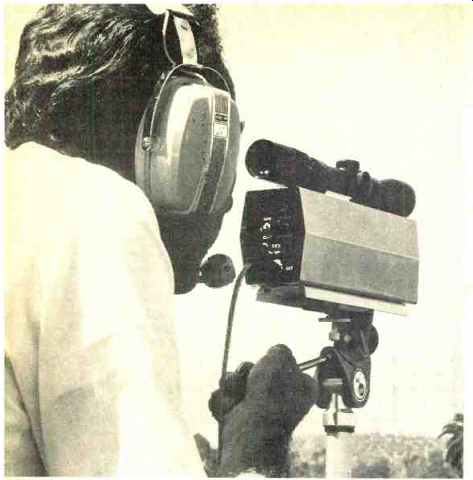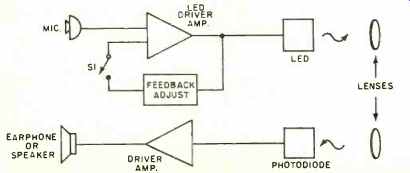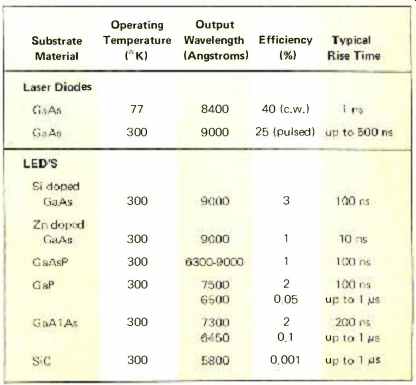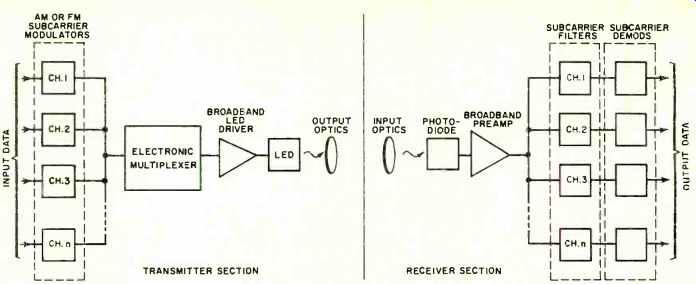(source: Electronics World, Dec. 1971)
By DAVID L. HEISERMAN

---This optical communicator, which transmits and receives voice or digital
information, is designed for "secure" point-to-point work.
With the r.f. spectrum so overcrowded, engineers are looking to light portion of the band to handle short-range optical communications links.
THE demand for additional broadband communications links is growing at an ever-increasing rate, and there seems to be no end in sight. The problem of overcrowded r.f. communications bands reached a critical point years ago; but, until very recently, the FCC and the communications industry have been at a loss for a truly satisfactory solution.
Development of the laser in the early 1960's gave communications technology the breakthrough it needed to perfect the old idea of light-beam communications. Unlike ordinary light, laser light can be multiplexed, heterodyned, beamed, demodulated, discriminated, and otherwise treated in ways quite analogous to microwave r.f. energy. But, unlike r.f. communications systems, optical communications links (OCL's) cannot interfere with one another under ordinary circumstances, and they are totally immune to both man-made and natural r.f. interference. What's more, OCL's cannot interfere with existing r.f. communications links.

Fig. 1. Block diagram of an experimental LED optical transceiver. Devices
such as this promise to become quite popular among electronics and science
experimenters in future.
The extraordinarily high frequency of a laser-beam "carrier" lends itself quite naturally to high-capacity broadband communications. A single laser beam carrier, for instance, can handle several conventional TV channels, three or four streams of high-speed digital data, some Picture-phone signals, and hundreds of voice-grade channels--all with room to spare. Even the relatively incoherent infrared light from inexpensive light-emitting diodes (LED's) can carry several channels of TV information and computer data on a single beam.
Optical communications, then, seems to be the ideal solution to the problem of r.f. communications overcrowding.
However, optical communications is still in its infancy and few companies can boast of an inventory of finished OC instruments. Dozens of companies have developmental or prototype models in operation and information from the R &D labs indicates that OCL's will be taking over a significant portion of the r.f. communications overload by the mid-1970's.
At the present time, developmental work in optical communications falls into two distinct categories: (1) versatile short-range systems using laser diodes or LED's as light sources, and (2) long-range, high-performance systems using conventional gas or solid-state laser sources. Devices in the first category will eventually take over jobs now handled by radio transceivers and short-haul cables and r.f. links. The bigger communicators will handle long-haul, high-capacity tasks now performed by a wide variety of commercial, private, military, and government communications systems.
Single-Channel LED Communicators
An LED emits light energy whenever current flows in a forward direction through its p-n junction and the amount of light output is roughly proportional to the amount of forward-biasing current. Most LED's, those made from silicon-doped gallium-arsenide, emit a peak of 100 milliwatts of light energy in the infrared portion of the light spectrum. Although LED light lacks the coherence of laser light, it is quite pure compared to ordinary incandescent light-a typical infrared-emitting LED has a spectral band width of only 200 angstroms between half-power points. A fast response time, on the order of 10 nanoseconds, also helps make LED's ideal sources of light for short-range, intensity-modulated voice and data communicators.
LED modulator circuits are so simple and reliable that electronics buffs are beginning to have a field day designing and building short-range LED voice communicators.
Used with a set of 1-inch lenses or small telescopes, a LED transceiver can operate over a range of about 250 feet in broad daylight and ten times that far on a clear night. Not counting the optics, the parts for an experimenter's intensity modulated LED transceiver runs between $15 and $25.
Fig. 1 is a block diagram of an experimenter's LED transceiver. Low-level audio signals from the microphone go through a current amplifier circuit that serves as a LED driver. Since the amount of light energy from the LED is very nearly proportional to the amount of forward-biasing current flowing through it, audio signals from the driver intensity-modulate the output light energy. A lens following the LED focuses the light into a narrow beam, thus increasing the effective transmission range.
Closing S1 completes a positive feedback loop around the LED driver amplifier. The feedback-adjust circuit contains RC components that let the amplifier oscillate at some fixed audio frequency-generally around 1 kHz. These oscillations modulate the LED output and provide a convenient audio signal for aligning the transmitter with a remote receiver unit. Once the operators make the initial alignment, opening S1 stops the alignment tone.
A clever circuit designer will bias the LED and driver amplifier just a bit below cut-off. Although this trick introduces some audio distortion, it buys the user two advantages: (1) the transmitter, in effect, will be voice activated and (2) it makes it possible to increase the LED's peak output power. When there is no signal from the microphone the LED and driver amplifier consume virtually no power, making it practical to leave the transmitter in a standby mode at all times. Class-B current pulses from the LED driver also allow the user to operate the LED in it pulse mode and thus increase the peak output power.
The lens in the receiver section gathers in light signals from a remote transmitter and focuses the energy onto a photodiode. The incoming light signals modulate the photodiode's current, and a current amplifier boosts the signal level to drive an earphone or loudspeaker. Slight cut-off bias on the photodiode and amplifier can also make the receiver into a signal activated device.
By using the infrared portion of the light spectrum, LED communicators are relatively insensitive to most kinds of ambient light. Sunlight, unfortunately, contains a great deal of infrared energy that tends to saturate the photodiode.
An external sensitivity control lets the operator adjust the cut-off bias on the photodiode and thus cancel out the effects of stray infrared energy when operating the system in broad daylight.
Isolating the receiver circuit from the transmitter circuits eliminates the need for a send / receive switch. Optical isolation is much easier to achieve than r.f. circuit isolation-the designer merely takes reasonable care to make sure no light from the LED can reach the nearby photodiode.
One of the essential features of the simple LED transceiver just described is that it modulates the light source directly and does not rely upon some separate modulation device such as a vibrating mirror or voltage sensitive optical filter. Directly modulated light sources, in fact, represent one of the greatest advantages semiconductor light sources have over conventional gas or solid-state laser sources.
In principle at least, just about every feature of the experimenter's transceiver carries over to high-performance LED optical communicators. The high-performance communicators might use better optical systems, higher quality LED's and photodiodes, some schemes to get more power out of the source, and extra circuitry such as a.g.c. and noise controls; but the basic principles are the same for a hobby LED transceiver as for a six-mile LED data link. Even the process of multiplexing a number of wideband channels onto an LED beam is often more a matter of adding outboard electronics than making any significant changes in the basic modulator and detector schemes.

--- Laser diode and LED specs related to optical communications.
Multiplexed LED Communicators
The real advantages of optical communications come into play only when users take advantage of the extraordinarily high information capacity of coherent or near-coherent light. Although short-range, single-channel voice or data LED communicators may become quite popular within the next few years, the real R &D efforts are going into high quality, multi-channel versions. Right now, three kinds of multiplexing schemes are getting the attention of leading R &D labs: frequency, time-division, and spatial multiplexing.
The most promising frequency-multiplexing scheme uses purely electronic techniques to generate and modulate an electrical subcarrier for each information channel. The sub carrier modulation may be AM, FM, or a combination of the two. See Fig. 2. An electronic multiplexer circuit brings all the channels together while a set of electronic filters minimizes any subcarrier crosstalk. Only after going through all the multiplexing and filtering processes do the signals go to a broadband LED driver and to the LED itself.
In theory, the only factors that limit the information-handling capacity of this frequency-multiplexed LED communications system are the bandwidths of the individual channels and the purity of the light source. In practice, however, the limitations are due more to a lack of electronic devices and know-how needed to take full advantage of a 30,000-GHz carrier.
These frequency-multiplexed LED communicators are among the most popular OC devices in use today. A group of researchers at the University of Colorado, for example, has developed a frequency-multiplexed LED communicator now used by a CATV firm to carry TV signals from a mountain-top microwave antenna to a city in the valley below. The system has a range of six miles and it completely eliminates the need for stringing cables down the rugged mountainside. This particular system, by the way, has worked 99.9% of the time (the 0.1% loss of communications was due to an exceptionally heavy snowstorm).

Fig. 2. Block diagram of an "n "channel type frequency-multiplexed
LED transceiver.
A second kind of LED frequency-multiplexing scheme, often called color multiplexing, uses a separate LED for each channel of information. By using a selection of LED's that have slightly different spectral outputs, it is possible to intensity-modulate each LED and combine the outputs into a single, multi-color beam. A set of photodiodes, each spectrally matched to one of the LED's, separates the channels at the receiver end of the communications link.
Color multiplexing eliminates the need for elaborate electronic frequency-multiplexing circuitry, but the scheme suffers from one big disadvantage: LED's using silicon or gallium-arsenide have a preference for operating in the 9000-angstrom range. LED's doped to operate in the 8000 to 6000angstrom (visible red and yellow) range have substantially lower outputs than the typical infrared version. Future LED developments may solve this problem; but until that time arrives, color multiplexing will be restricted to very-short-range optical coupling applications sending 6 or 8 channels of computer data across a room, for example.
With a typical digital capacity of 50 megabits per second, LED communicators show great promise in time-division multiplexing. Since time-multiplexed LED communicators can handle hundreds of computer data channels simultaneously, all the major computer firms hope to begin supplying LED links for local time-sharing traffic. Compared to the voice-grade telephone lines that carry most time-sharing traffic today, the data capacity of a single LED link is virtually limitless. LED links will not only make it easier to connect more teletypewriter terminals to a computer facility, but will make high-capacity operations, such as interactive graphics, more feasible than they are at present.
Right now, spatial multiplexing is the least versatile of the three LED multiplexing schemes. Spatially multiplexed LED communicators use one LED for each data channel; but unlike the color multiplexing operation, LED's in the spatial scheme may have the same output wavelengths.
The trick is to keep the light beams separated from one another so that they fall onto an array of receiver photo diodes in a one-for-one pattern. This is no small trick, considering LED light is only quasi-coherent and thus has a tendency to "smear" as it moves through space.
One way to keep the beams from becoming hopelessly scrambled in transit is to run them through sets of collimating lenses spaced at regular intervals along the transmission path. A more effective technique is to couple each LED to the proper photodiode through fiber optics. Since the frequency and time-division multiplexing schemes do not require any kind of optical manipulation along the transmission path, spatially multiplexed LED communicators are pretty much out of the running in most OCL applications.
Their only real promise appears to be in across-the-room types of applications.
Laser diodes, or injection lasers, produce coherent light when forward biased with a current that exceeds a lasing threshold of about 2 amperes. Laser diodes can also produce up to 4 watts of output power with efficiencies on the order of 40%. Unfortunately, the optimum operating temperature for laser diodes is about 77°K (room temperature is 300°K). Operating a laser diode at room temperature degrades its performance to a point where it can barely compete with an inexpensive LED. Laser diodes must be operated in a pulse mode at room temperature. State-of-the-art laser diodes have minimum pulse response times in the neighborhood of 0.1 microsecond and duty factors of less than 1%. Thus, the peak operating frequency is around 100 kHz. It is possible to achieve higher pulse repetition rates, but the duty factor then limits the power output to a fraction of a watt.
The only feasible kinds of direct modulation for a laser diode communicator are those that use pulse-modulation techniques-pulse-frequency or pulse-displacement modulation, for example. Even then, the extremely low repetition rates limit the information capacity to one or two voice-grade channels or a single 50-kilobit-persecond data channel.
In spite of these severe limitations upon their information capacity, single-channel laser-diode communicators manage to hold their own in the industrial and military marketplace. The real advantage of laser-diode communicators is that the coherence and high power outputs make it possible to reach ranges on the order of 10 miles without resorting to large-aperture optics. The signal-to-noise ratio for laser-diode communicators is much greater than that possible with LED versions.
The Santa Barbara Research Center, a subsidiary of Hughes Aircraft, now markets a laser-diode transceiver designed to carry a single channel of PFM voice or digital data. The transmitter drives the laser diode with 100-ns pulses that are frequency-modulated around a 6-kHz carrier. Using only 1-inch lenses and constructed in a binocular arrangement, the system's peak power output of 2 watts gives these communicators an operating range of 6 miles.
Compared to conventional gas or solid-state laser sources, semiconductor light sources are more rugged, smaller, cheaper, and easier to modulate and require much lower operating voltages. These features make semiconductor OCL equipment especially suited as portable communicators or short-haul optical links that require little routine maintenance.
On the negative side of the ledger, the semiconductor sources have much lower output capabilities than conventional lasers. In outer space where the line-of-sight range is limitless, OCL's using high-power conventional laser sources can have operating ranges measured in thousands of miles. Although OCL's established around conventional laser sources are elaborate and expensive affairs, their long haul capability justifies their existence.